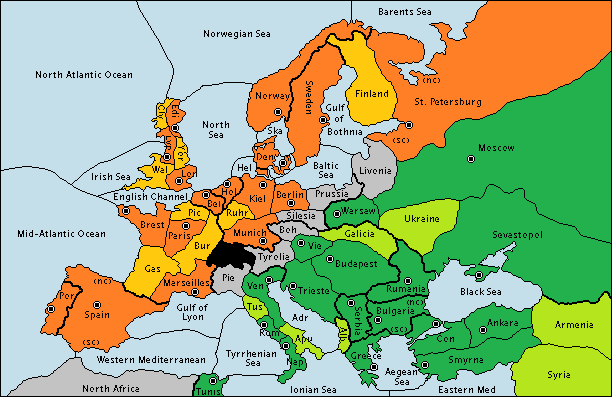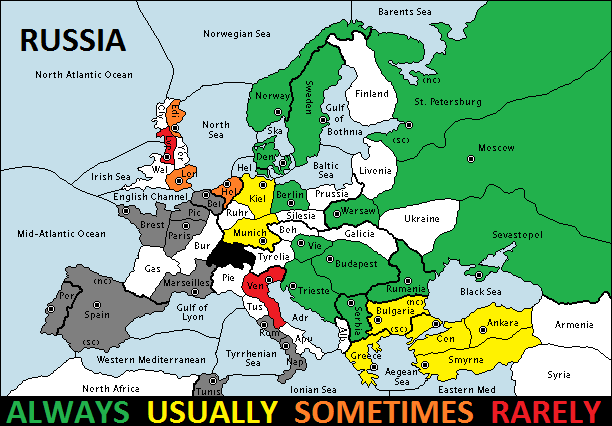
Russia, uniquely, has 4 home centers.
In my personal strategic theory of gunboat Diplomacy, I consider Russia to function as two almost separate powers: “Northern Russia” and “Southern Russia.” I wrote about this some in my Russian Solo Win Guide for gunboat Diplomacy. In this post, let me explain further.
Russia has 1 Northern port and 1 Southern port
Russia has 1 port in the north (St. Petersburg) and 1 port in the south (Sevastopol), and any fleets built on either side will never interact with each other. Russia would have won the game before circumnavigating Europe with a fleet.
This matches up with how I generally divide up the map into 2 spheres:
- The “Northern” sphere—England, France, Germany, their natural neutrals + St. Petersburg
- The “Southern” sphere—Italy, Austria, Turkey , their natural neutrals + Warsaw, Moscow, Sevastopol
These two spheres each contain 17 supply centers, and most powers’ solo-win plans involve conquering their entire sphere + 1-2 centers in the other sphere. (Have a look at my Gunboat Solo Win Guides for more information.)

Orange is “North” and green is “South.” The gray area is “no-man’s-land.”
Russia can draw with just one of these halves
An invading power usually cannot, alone, conquer all of Russia. A power attacking from the south cannot usually take St. Petersburg or anything past it, and an invading power from the north faces a difficult time getting past Warsaw and/or Moscow (but that’s a little bit more achievable). Because of this, it is typical for one half of Russia to be completely shut down while the other achieves some success. So for example, if “Northern Russia” takes over Scandinavia, Turkey, Italy or Austria cannot, between them, eliminate Russia. Similarly, if Russia makes sufficient progress against Turkey or in the Balkans, France, England and probably Germany could never, between them, eliminate Russia.
Even if one half of Russia is shut down, the other half, for the reasons I stated, can still get into the draw. This is a pretty typical way to play Russia in a gunboat game: Get quickly shut out of one side of the board, then to limp into a draw with the other half.
“Northern” Russia and “Southern” Russia appeal to different allies
Most Diplomacy guides will discuss whether “Russia” is a natural or useful ally to a given power and how such an alliance might work. Discussing “Russia” as a unitary concept in this context can be misleading, and this is a situation where the two-power theory of Russia I advocate is illuminating.
For example, is “Russia” a natural ally to Italy or not? Most Diplomacy guides will tell you that Russia and Italy are “natural allies.” I say, “Southern” Russia is a great ally for Italy, but “Northern Russia” is a nuisance at best:
“Southern Russia“ can expand very far into the south, attacking Austria and/or Turkey, without encroaching on Italy‘s expansion path. In the late-game, Italy can often roll back “Southern” Russia‘s gains (usually all the way back to Warsaw and Moscow, sometimes even taking those centers as well) for a solo win. Because of this, Italy can almost freely dispense assistance to “Southern Russia” and benefits immensely from a strong “Southern Russian” game.
“Northern Russia” expands by attacking the two powers that Italy is counting on to hold France down (England and Germany ), usually crushing Italy‘s best ally (Germany). This leads to a powerful French game, and which likely means Italy‘s chance of a solo win are reduced to nothing (Italy is counting on taking French centers, but a powerful France can easily defend itself and may even come after Italy‘s Tunis). Furthermore, if “Northern Russia” has expanded far into the north, Italy cannot eliminate “Northern Russia” from the draw and might even risk a French solo win if Italy attacks Russia later on.
Putting it All Together: Northern and Southern expansion are required for a Russian solo win

Russia’s path to victory is completely different from any other power. Russia needs to advance far into both the North and South to win.
For Russia to solo win, Russia likely needs to make progress with both sides, expanding both North and South. This is easier to pull off than you might think, because if Russia has a foothold on each sphere of the map, Russia can use the builds gained from one side of the map to build new units for use on the other side of the map (
For example, maybe Russia gets Sweden and Norway and then stalls in the north. Later, if Russia gets a build due to capturing a center in the south, Russia could add a 3rd fleet to the northern forces and start making progress again in the north. Then Russia might capture other northern center and build a new unit in the south to break though some defensive position on that side. And so on! Check out my cheat-sheet guide on getting a solo win as Russia for more information.
This exactly captures something I have had trouble with in two consecutive games but am starting to figure out how to manage. Russia is just so everywhere. That shifting builds thing as needed is something I have been starting to do only now, part way into the second game. I am relatively new to diplomacy and this article is helpful for understanding how to play Russia’s size well.
Thank you! This is one of the first Diplomacy articles I published. Looking at this again, it is so short and simple compared to what write these days! I’m so glad you found it helpful.